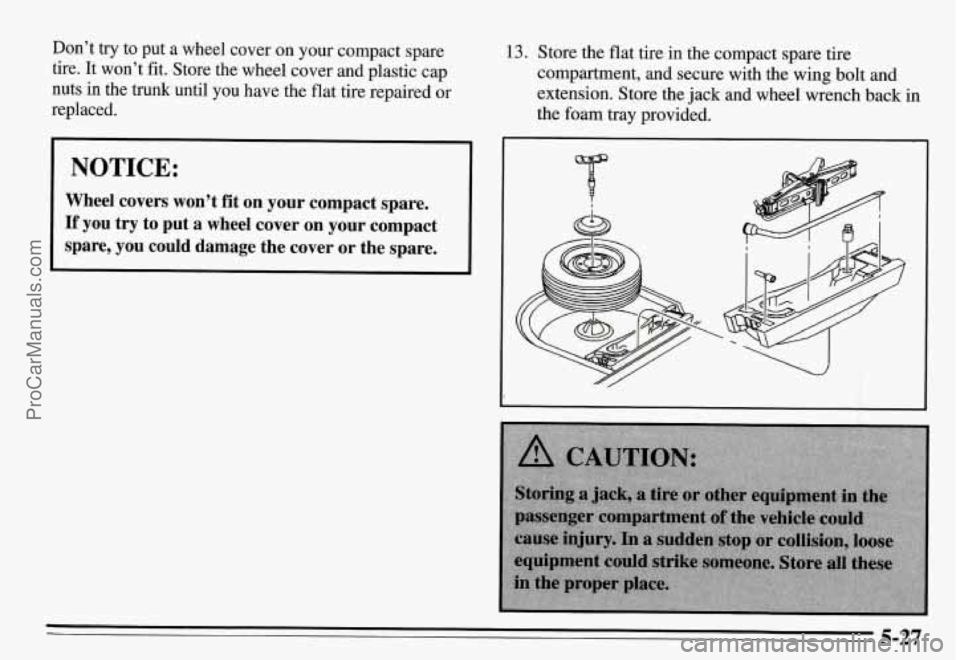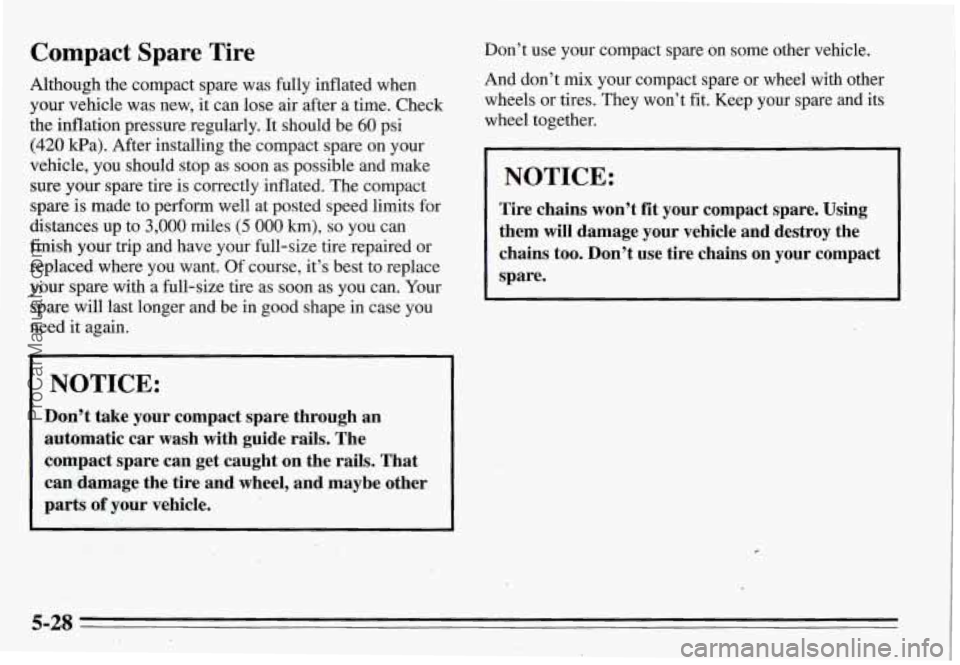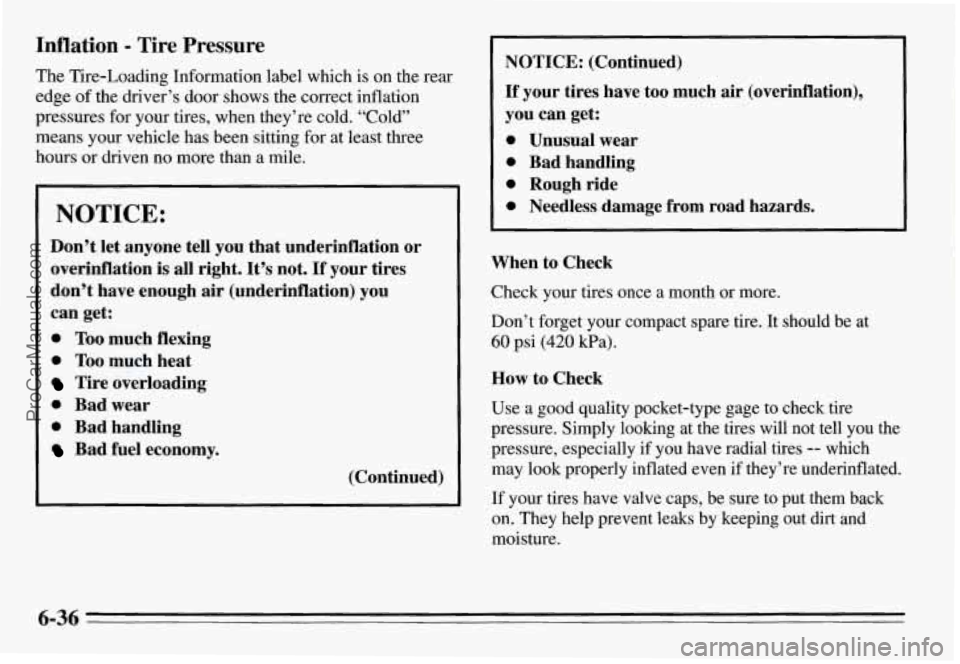1995 PONTIAC GRAND-AM flat tire
[x] Cancel search: flat tirePage 208 of 354

Don’t try to put a wheel cover on your compact spare
tire. It won’t fit. Store the wheel cover and plastic cap
nuts in the trunk
until you have the flat tire repaired or
replaced.
NOTICE:
Wheel covers won’t fit on your compact spare.
If you try to put a wheel cover on your compact
spare, you
could damage the cover or the spare.
13. Store the flat tire in the compact spare tire
compartment, and secure with the wing bolt and
extension. Store the jack and wheel wrench back in
the foam tray provided.
I
5-27
ProCarManuals.com
Page 209 of 354

Compact Spare Tire
Although the compact spare was fully inflated when
your vehicle was new, it can lose air after a time. Check
the inflation pressure regularly. It should be
60 psi
(420 Wa). After installing the compact spare on your
vehicle, you should stop as soon as possible and make
sure your spare tire is correctly inflated. The compact
spare is made to perform well at posted speed limits for
distances up to
3,000 miles (5 000 km), so you can
finish your trip and have your full-size tire repaired or
replaced where you want. Of course, it’s best to replace
your spare with a full-size tire as soon as you can. Your
spare will last longer and be in good shape in case you
need it again.
I NOTICE:
Don’t take your compact spare through an
automatic car wash with guide rails. The
compact spare can get caught on the rails. That
can damage the tire and wheel, and maybe other
parts of your vehicle.
Don’t use your compact spare on some other vehicle.
And don’t mix your compact spare or wheel with other
wheels or tires. They won’t fit. Keep your spare and its
wheel together.
NOTICE:
Tire chains won’t fit your compact spare. Using
them
will damage your vehicle and destroy the
chains too. Don’t use tire chains on your compact
spare.
5-28
ProCarManuals.com
Page 247 of 354

Inflation - Tire Pressure
The Tire-Loading Information label which is on the rear
edge of the driver’s door shows the correct inflation
pressures for your tires, when they’re cold. “Cold”
means your vehicle has been sitting for at least three
hours or driven no more than a mile.
I NOTICE:
Don’t let anyone tell you that underinflation or
overinflation
is all right. It’s not. If your tires
don’t have enough
air (underinflation) you
can get:
0 Too much flexing
0 Too much heat
Tire overloading
0 Bad wear
0 Bad handling
Bad fuel economy.
(Continued)
1 NOTICE: (Continued)
If your tires have too much air (overinflation),
you can get:
0 Unusual wear
0 Bad handling
0 Rough ride
0 Needless damage from road hazards.
When to Check
Check your tires once a month or more.
Don’t forget your compact spare tire. It should be at
60 psi (420 Wa).
How to Check
Use a good quality pocket-type gage to check tire
pressure. Simply looking at the tires will not tell you the
pressure, especially if you have radial tires
-- which
may look properly inflated even if they’re underinflated.
If your tires have valve caps, be sure to put them back
on. They help prevent leaks by keeping out dirt and
moisture.
6-36
ProCarManuals.com
Page 248 of 354

Tire Inspection and Rotation
Tires should be inspected every 6,000 to 8,000 miles
(1 0 000 to 13 000 km) for any signs of unusual wear. If
unusual wear is present, rotate your tires as soon as
possible
and check wheel alignment. Also check for
damaged tires or wheels. See “When it’s Time for New
Tires”
and “Wheel Replacement” later in this section for
more information.
The purpose of regular rotation is to achieve more uniform
wear for all tires on the vehicle. The first rotation is the
most important.
See “Scheduled Maintenance Services” in
the Index for scheduled rotation intervals.
When rotating your tires, always use the correct rotation
pattern shown here.
Don’t include the compact spare tire in your tire
rotation.
After the tires have been rotated, adjust the front and
rear inflation pressures as shown on the Tire-Loading
Information label. Make certain that all wheel nuts are
properly tightened. See “Wheel Nut Torque” in the
Index.
6-37
ProCarManuals.com
Page 251 of 354

Temperature - A, B, C
The temperature grades are A (the highest), B, and C,
representing the tire's resistance to the generation of
heat and its ability to dissipate heat when tested under
controlled conditions on a specified indoor laboratory
test wheel. Sustained high temperature can cause the
material
of the tire to degenerate and reduce tire life, and
excessive temperature can lead to sudden tire failure.
The grade C corresponds to a level of performance
which all passenger car tires must meet under the
Federal Motor Vehicle Safety Standard
No. 109. Grades
B and A represent higher levels of performance on the
laboratory test wheel than the minimum required by law.
Warning: The temperature grade for this tire is
established for a tire that is properly inflated and not
overl'oaded. Excessive speed, underinflation, or
excessive loading, either separately or in combination,
can cause heat buildup and possible tire failure.
These grades are molded on the sidewalls of passenger
car tires.
While the tires available as standard or optional
equipment on General Motors vehicles may vary with
respect to these grades, all such tires meet General
Motors performance standards and have been approved
for use on General Motors vehicles. All passenger type
(P Metric) tires must conform to Federal safety
requirements in addition to these grades.
Wheel Alignment and Tire Balance
The wheels on your vehicle were aligned and balanced
carefully at the factory to give you the longest tire life
and best overall performance.
In most cases, you will not need to have your wheels
aligned again. However, if you notice unusual tire wear
or your vehicle pulling one way
or the other, the
alignment may need to be reset.
If you notice your
vehicle vibrating when driving on a smooth road, your
wheels may need to be rebalanced.
ProCarManuals.com
Page 270 of 354

Section 7 Maintenance Schedule
IMPORTANT:
KEEP ENGINE OIL
AT THE PROPER
LEVEL AND CHANGE AS
RECOMMENDED
This section covers the maintenance required for your
Pontiac. Your vehicle needs these services to retain its
safety, dependability and emission control performance. ~~
1
Protection I
Have you purchased the GM Protection Plan? The Plan
supplements
your new vehicle warranties. See your
Pontiac dealer for details.
Introduction
Your Vehicle and the Environment
Proper vehicle maintenance not only helps to keep your
vehicle in good working condition, but also helps the
environment. All recommended maintenance procedures
are important. Improper vehicle maintenance or the
removal
of important components can significantly
affect the quality of the air we breathe. Improper fluid
levels or even the wrong tire inflation can increase the
level of emissions from your vehicle.
To help protect our
environment, and to help keep your vehicle
in good
condition, please maintain your vehicle properly.
7-1
ProCarManuals.com
Page 307 of 354

Part B: Owner Checks and Services
Listed below are owner checks and services which
should be performed at the intervals specified to help
ensure the safety, dependability and emission control
performance of your vehicle.
Be sure any necessary repairs are completed at once.
Whenever any fluids or lubricants are added to your
vehicle, make sure they are the proper ones, as shown in
Part
D.
At Each Fuel Fill
It is important for you or a service station attendant to
perfom these underhood checks at eachfuelfill.
Engine Oil Level
Check the engine oil level and add the proper oil if
necessary. See “Engine Oil” in the Index for further
details.
Engine Coolant Level
Check the engine coolant level and add the proper
coolant mix
if necessary. See “Coolant” in the Index for
further details.
Windshield Washer Fluid Level
Check the windshield washer fluid level in the
windshield washer tank and add the proper fluid
if
necessary. See “Windshield Washer Fluid” in the Index
for further details.
At Least Once a Month
Tire Inflation
Check tire inflation. Make sure tires are inflated to the
pressures specified on the Tire-Loading Information
label located on the rear edge
of the driver’s door. See
“Tires” in the Index for further details.
Cassette Deck
Clean cassette deck. Cleaning should be done every 50
hours of tape play. See “Audio Systems” in the Index for
further details.
At Least Twice a Year
Hydraulic Clutch System Inspection
Check the fluid level in the clutch reservoir. See
“Hydraulic Clutch Fluid” in the Index. A fluid loss in
this system could indicate a problem. Have the system
inspected and repaired at once.
7-38
ProCarManuals.com
Page 323 of 354

Pontiac Roadside Assistance Program
Security While You Travel
As the proud owner of a new Pontiac vehicle, you are
automatically enrolled in the Pontiac Roadside
Assistance Program. This value-added service
is
intended to provide you with peace of mind as you drive
in the city or travel the open road.
Pontiac’s Roadside Assistance toll-free number is
staffed by a team of technically trained advisors who are
available
24 hours a day, 365 days a year.
We take anxiety out of uncertain situations by providing
minor repair information over the phone or making
arrangements to tow your vehicle to the nearest Pontiac
dealer.
We will provide the following services for
3 years/36,000 miles, at no expense to you:
Vehicle out of fuel
0 Keys locked in vehicle
0 Tow to nearest dealer for warranty
1-800-ROADSIDE 1-800-762-3743
0
0
0
Change a flat tire
Jump starts Courtesy Transportation. For warranty repairs during
the Bumper-to-Bumper coverage period, interim
transportation may be available under the Pontiac
Courtesy Transportation Program. Please consult
your dealer for details.
In Canada, please consult
your
GM dealer for information on Courtesy
Transportation.
We have quick, easy access to telephone numbers of the
following services depending on your needs:
Hotel
0 Glass replacement
0 Rental vehicles or taxis
0 Police, fire department or hospitals
In many instances, mechanical failures are covered
under Pontiac’s comprehensive warranty. However,
when other outside services are utilized, our advisors
will explain any payment obligations you might incur.
8-6
ProCarManuals.com